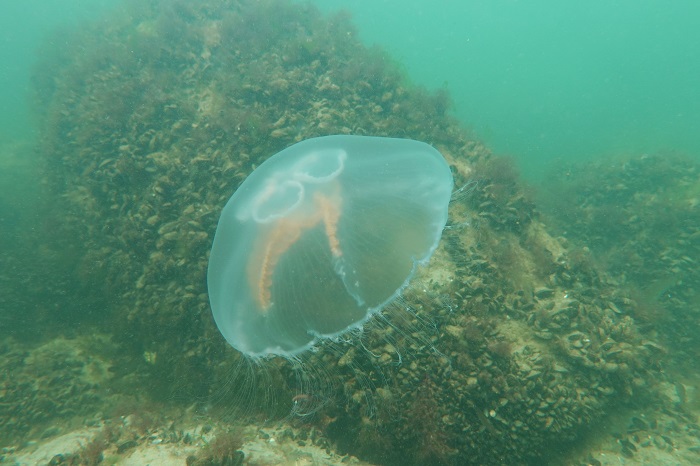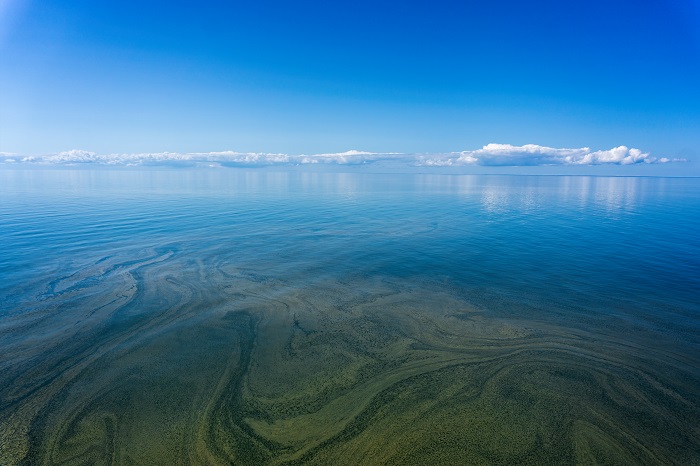
In recent decades, the Baltic Sea has begun to recover, but still contains unfavourable phenomena. Anaerobic deserts are growing, cyanobacterial blooms are intensifying, and underwater engineering works raise toxins from the bottom, which eventually end up in the food chain, says Dr. Lech Kotwicki from the Polish Academy of Sciences.
Dr. Kotwicki is a professor at the Institute of Oceanology of the Polish Academy of Sciences in Sopot. He is an expert in the coastal marine ecosystem ecology, ecology of marine fauna and the impact of tourism on the coastal zone.
When asked how experts assess the current state of the Baltic Sea, he emphasises that this was a very broad topic. 'Some time ago it seemed to me that we were going in a very good direction. After the 1970s and 1980s, when the Baltic Sea situation was very bad, when beaches were being closed due to the quality of waters - we began to observe a reduction in the inflow of pollutants, including those causing eutrophication, so-called nutrients. The political transformation of countries such as Poland was of great importance. Underwater meadows have been restored, allowing for the development of numerous organisms and giving them shelter. Some species that were thought to be extinct have returned. This is clearly visible, for example, in Puck Bay - more and more fish can be found in the revived meadows, for example strictly protected pipefish related to the seahorse,’ he says.
But, he adds, ’I hoped that this trend would continue and we would see more and more success every year. Unfortunately, the report of the Helsinki Commission dealing with the Baltic Sea, whose recommendations we are trying to implement, shows that the previously assumed goals have not been achieved.’
Why? The problem results from the fact that the Baltic Sea is practically a closed body of water, the expert notes. 'Through the narrow Danish straits, the water in it is only minimally exchanged. Everything that we let into this sea stays in it. For example, we have not been able to achieve the assumed pollutant discharge reduction,’ he says.
Among the greatest threats to the Baltic Sea, the scientist mentions eutrophication. It occurs when too many nutrients containing nitrogen and phosphorus get into the water. These compounds come mainly from agricultural fields.
In order to assess who pollutes the sea the most in this way, it is necessary to take into account the area of its catchment - the area from which rivers carry what gets into them to the sea.
'If we look at the map, Poland is the largest agricultural country. We also have the largest rivers flowing into the Baltic Sea. So we bring by far the largest amount of this type of pollution to it. We have made a lot of progress as regards the construction of sewage treatment plants, but the Oder river disaster showed how ineffective our efforts can be. A lot of pollution is beyond our control, or the waters are poorly treated. There is no full control of what gets into the sea. Fortunately, when we calculate the amount of pollution per capita, we are not doing so badly,’ says Dr. Kotwicki.

Disturbing sediments on the seabed can also be damaging as many pollutants are deposited in them. 'Meanwhile, more and more coastal investments are currently being carried out. As a result, the substances accumulated in the sediments - which we thought would remain there - begin to leak into the water column,’ Kotwicki says. The scale of this problem depends on the intensity of work related to the disturbance of the Baltic Sea bottom sediments, and the number of such projects grows with technological progress and the desire and need to develop the waters of our sea.
The condition of the Baltic Sea is also influenced by the climate, including the steady increase of average temperatures. One of the observed effects are more and more intense blooms of blue-green algae, which are among of the oldest organisms on Earth. They are also - as the scientist emphasises - very resistant. When the temperature rises, they develop faster. Although biogenic substances flowing into the sea help them, cyanobacteria can cope without them, for example by capturing nitrogen from the air. That is why we observe powerful blooms that can be seen not only at the shore, but also in the central Baltic Sea, where they form huge surface scum.
Can it have dangerous consequences? 'Unfortunately it can. Blooms of blue-green algae, but also some other bacteria and algae, cause cascade reactions. When these organisms finally die, they sink to the bottom and the processes of their decomposition consume all the oxygen. The process is continued by anaerobic bacteria that secrete toxic substances such as methane and hydrogen sulphide. This is how dead zones grow, which are more numerous at the bottom of the Baltic Sea every year. Over the last 20 years, the area of such zones in the central part of the Baltic Sea has increased by 150 percent. These areas will probably remain dead and they will continue to grow', he says.
Restoration of these areas and biological life there is very difficult, because the water in the Baltic Sea is stratified: it is divided into layers. Firstly, they are separated by a thermocline, which in practice means that warmer water is at the top and cold water is at the bottom. These layers differ in salinity and practically do not mix. The bottom layer is not oxygenated.
According to Dr. Kotwicki, the effects of this situation can be clearly seen on the example of cod - a fish that spawns in the water depths. The eggs slowly sink to the bottom and should stop in the aforementioned thermocline, above the denser water at the bottom. The young hatch there. The dead zones beneath them, however, prevent them from developing. Cod feeds at the bottom and even those individuals that reach adulthood will not find food in barren areas.
Because, in addition, people catch cod, the condition of the populations is weakening. 'Although the closed periods have brought a lot of improvement, the fish are getting smaller and have more and more parasites - precisely because of fishing and water hypoxia. In the ocean, the situation of cod and other fish (e.g. mackerel) is improving. But if we don't act in the Baltic - cod may eventually disappear from it,’ Kotwicki warns.
There are also toxic compounds in the Baltic Sea, e.g. petroleum hydrocarbons, heavy metals and compounds leaking from chemical weapons lying at the bottom. Dr. Kotwicki also mentions plastic pollution. 'A large part of these pollutants is accumulated in sediments, which are now often disturbed by various construction works, including the construction of wind farms, laying pipelines, port extensions or dredging (supplying the shore with sand from greater depths). Toxins then end up in the food chain.
‘First they are absorbed by bacteria, plants, and then by the organisms that eat them. With each subsequent link, the concentration of toxins increases. We, as consumers, are mainly interested in fish. I am not saying that you should not eat them, I believe that it is still worth it, but we must remember that every action we take has consequences for us,’ Kotwicki continues.
The sea is also affected by underwater noise. Its main sources are tourism, water traffic and various types of construction projects, including wind farms. Various organisms suffer from this, including seals or the small population of porpoises.
How do scientists see the future of our sea in 10, 20 or 50 years? Will it be possible to swim and fish in it? Will there be life in it? 'I unequivocally say yes. We will still be able to enjoy the Baltic Sea, but much depends on ourselves,’ says Dr. Kotwicki. 'Many models indicate the great importance of our future actions related to climate, including global ones. Various scenarios are being considered. Regardless of the variant, the changes already taking place in the Baltic Sea will be difficult to slow down quickly, so life in it will persist, but it will it will certainly change. There will be more organisms better adapted to higher temperature and lower salinity, because it will drop. We are talking about the smallest organisms, as well as plants and animals, including fish. I hope that the population will recover. I will say this again, the direction and pace of change are still up to us'.

The ecologist mentions that the Baltic Sea is very young. 'It used to be a much saltier reservoir, and the evolution that has taken place so far has completely changed the composition of the flora and fauna. Now, however, these changes are mainly due to human activity. We haven't talked about sea level rise yet. (How much can it rise?). Glaciers are melting faster than expected, seas are becoming warmer and more acidic, threatening both ecosystems and human well-being. If carbon dioxide emissions continue to increase, by 2100 this level could increase by as much as 60-110 centimetres. In the northern part of the Baltic Sea, sea level rise is being mitigated by land rise, but in the southern part the sea level rise will be noticeable.’
Kotwicki adds: 'Now is the time to start really decisively acting globally on limiting climate change - also because catastrophic phenomena are occurring in various parts of the world. The risk to society and ecosystems is much lower if we manage to stop greenhouse gas emissions than if we allow them to continue to grow.
'When it comes to the Baltic Sea, as well as other water bodies and areas, the idea of the late American biologist Edward Wilson appeals to me. He claimed that if you give about 50 percent of the space back to nature, it will regenerate itself.
'I think even 30 percent will be enough. Humans will also benefit from this. For example, fish shoals spawning in such reserves in the Baltic Sea will look for new areas and eventually naturally increase their range to the areas where they can be fished. The same principle applies to the coast.
‘Some European countries, such as Belgium, have it almost completely built up. Fortunately, the Polish coast is still in good condition, with two national parks - Slovincian and Wolin, and Natura 2000 areas stretching along the entire coast. Catchments, areas from which various substances flow into rivers and finally get into the sea, are also important for the Baltic Sea. The rivers themselves are of great importance - for example, unregulated ones clean themselves much better.
‘Therefore, care for the Baltic Sea requires action on a larger spatial scale. Let's do something more with a view not only to the near future. Also formally speaking, according to the report of the Helsinki Commission, efforts to protect the Baltic Sea should be increased.’ (PAP)
PAP - Science in Poland, Marek Matacz
mat/ zan/ kap/
tr. RL













